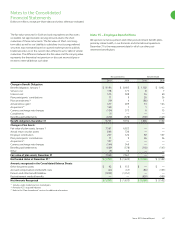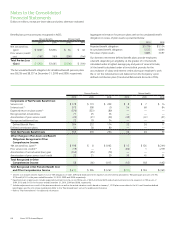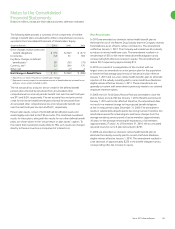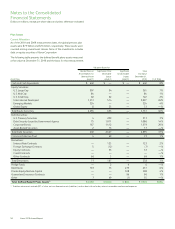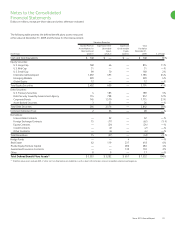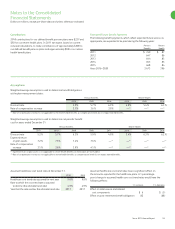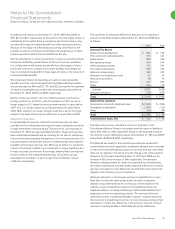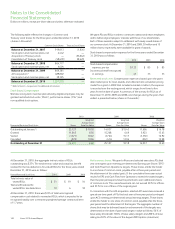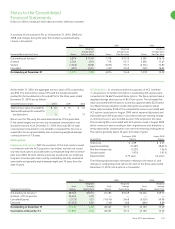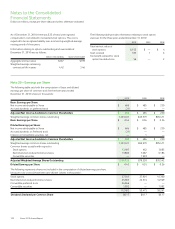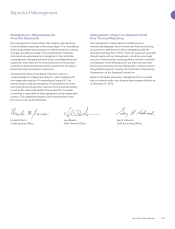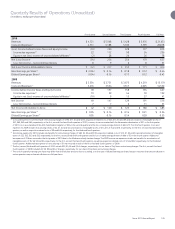Xerox 2010 Annual Report Download - page 98
Download and view the complete annual report
Please find page 98 of the 2010 Xerox annual report below. You can navigate through the pages in the report by either clicking on the pages listed below, or by using the keyword search tool below to find specific information within the annual report.Notes to the Consolidated
Financial Statements
Dollars in millions, except per-share data and unless otherwise indicated.
96 Xerox 2010 Annual Report
Legal Matters
As more fully discussed below, we are involved in a variety of claims,
lawsuits, investigations and proceedings concerning securities law,
intellectual property law, environmental law, employment law and the
Employee Retirement Income Security Act (“ERISA”). We determine
whether an estimated loss from a contingency should be accrued by
assessing whether a loss is deemed probable and can be reasonably
estimated. We assess our potential liability by analyzing our litigation
and regulatory matters using available information. We develop our
views on estimated losses in consultation with outside counsel handling
our defense in these matters, which involves an analysis of potential
results, assuming a combination of litigation and settlement strategies.
Should developments in any of these matters cause a change in our
determination as to an unfavorable outcome and result in the need to
recognize a material accrual, or should any of these matters result in a
final adverse judgment or be settled for significant amounts, they could
have a material adverse effect on our results of operations, cash flows
and financial position in the period or periods in which such change in
determination, judgment or settlement occurs.
Litigation Against the Company
In re Xerox Corporation Securities Litigation: A consolidated securities
law action (consisting of 17 cases) is pending in the United States
District Court for the District of Connecticut. Defendants are the
Company, Barry Romeril, Paul Allaire and G. Richard Thoman. The
consolidated action is a class action on behalf of all persons and entities
who purchased Xerox Corporation common stock during the period
October 22, 1998 through October 7, 1999 inclusive (“Class Period”) and
who suffered a loss as a result of misrepresentations or omissions by
Defendants as alleged by Plaintiffs (the “Class”). The Class alleges that
in violation of Section 10(b) and/or 20(a) of the Securities Exchange Act
of 1934, as amended (“1934 Act”), and SEC Rule 10b-5 thereunder, each
of the defendants is liable as a participant in a fraudulent scheme and
course of business that operated as a fraud or deceit on purchasers of
the Company’s common stock during the Class Period by disseminating
materially false and misleading statements and/or concealing material
facts relating to the defendants’ alleged failure to disclose the material
negative impact that the April 1998 restructuring had on the Company’s
operations and revenues. The complaint further alleges that the alleged
scheme: (i) deceived the investing public regarding the economic
capabilities, sales proficiencies, growth, operations and the intrinsic
value of the Company’s common stock; (ii) allowed several corporate
insiders, such as the named individual defendants, to sell shares of
privately held common stock of the Company while in possession of
materially adverse, non-public information; and (iii) caused the individual
plaintiffs and the other members of the purported class to purchase
common stock of the Company at inflated prices. The complaint seeks
unspecified compensatory damages in favor of the plaintiffs and the
other members of the purported class against all defendants, jointly and
severally, for all damages sustained as a result of defendants’ alleged
wrongdoing, including interest thereon, together with reasonable costs
and expenses incurred in the action, including counsel fees and expert
fees. In 2001, the Court denied the defendants’ motion for dismissal of
At December 31, 2010, we had tax credit carryforwards of $409
available to offset future income taxes, of which $109 are available
to carry forward indefinitely, while the remaining $300 will expire
2011 through 2027 if not utilized. We also had net operating loss
carryforwards for income tax purposes of $1,236 that will expire 2011
through 2029, if not utilized, and $2,478 billion available to offset
future taxable income indefinitely.
Note 17 – Contingencies
Brazil Tax and Labor Contingencies
Our Brazilian operations are involved in various litigation matters
and have received or been the subject of numerous governmental
assessments related to indirect and other taxes, as well as disputes
associated with former employees and contract labor. The tax matters,
which comprise a significant portion of the total contingencies,
principally relate to claims for taxes on the internal transfer of inventory,
municipal service taxes on rentals and gross revenue taxes. We are
disputing these tax matters and intend to vigorously defend our
positions. Based on the opinion of legal counsel and current reserves
for those matters deemed probable of loss, we do not believe that the
ultimate resolution of these matters will materially impact our results
of operations, financial position or cash flows. The labor matters
principally relate to claims made by former employees and contract
labor for the equivalent payment of all social security and other related
labor benefits, as well as consequential tax claims, as if they were
regular employees. As of December 31, 2010, the total amounts related
to the unreserved portion of the tax and labor contingencies, inclusive
of any related interest, amounted to approximately $1,274, with the
increase from December 31, 2009 balance of approximately $1,225
primarily related to currency and current year interest indexation
partially offset by matters that have been closed. With respect to the
unreserved balance of $1,274, the majority has been assessed by
management as being remote as to the likelihood of ultimately resulting
in a loss to the Company. In connection with the above proceedings,
customary local regulations may require us to make escrow cash deposits
or post other security of up to half of the total amount in dispute. As of
December 31, 2010 we had $276 of escrow cash deposits for matters
we are disputing and there are liens on certain Brazilian assets with a
net book value of $19 and additional letters of credit of approximately
$160. Generally, any escrowed amounts would be refundable and any
liens would be removed to the extent the matters are resolved in our
favor. We routinely assess all these matters as to probability of ultimately
incurring a liability against our Brazilian operations and record our best
estimate of the ultimate loss in situations where we assess the likelihood
of an ultimate loss as probable.



